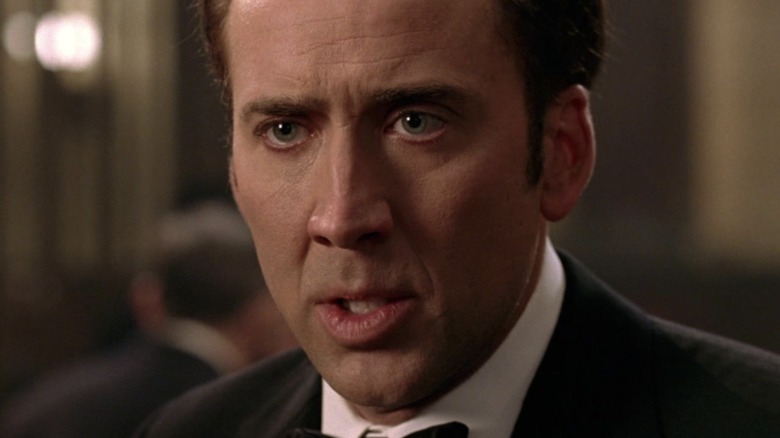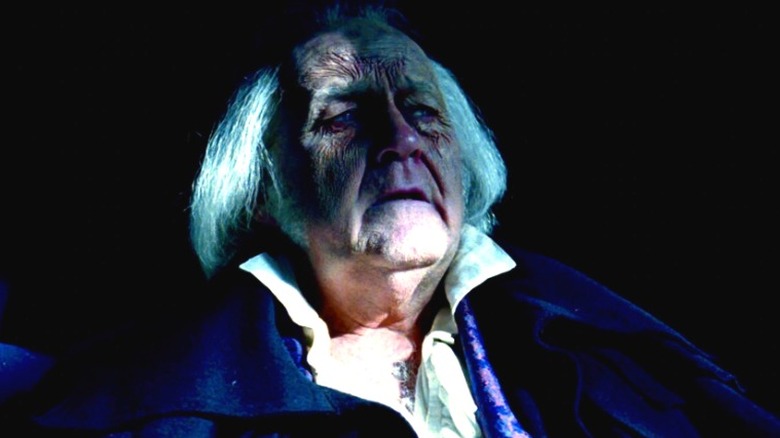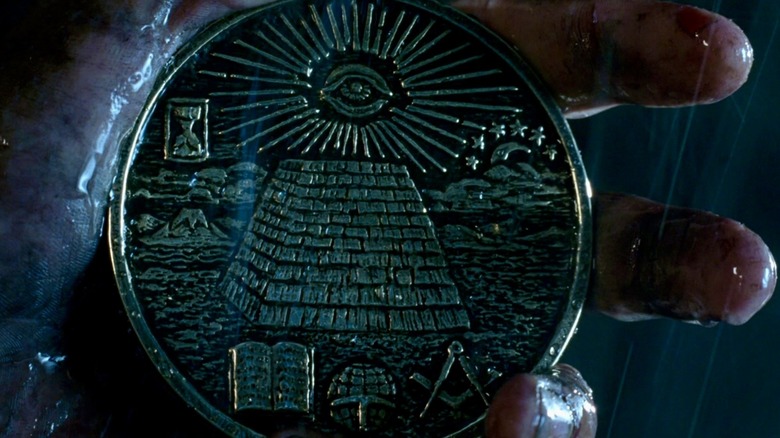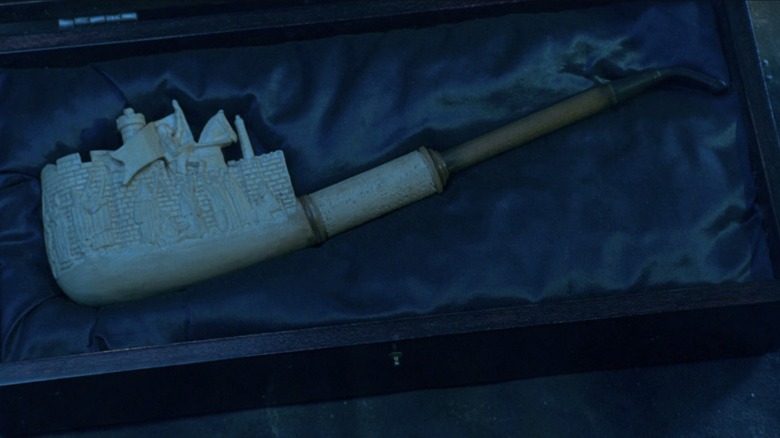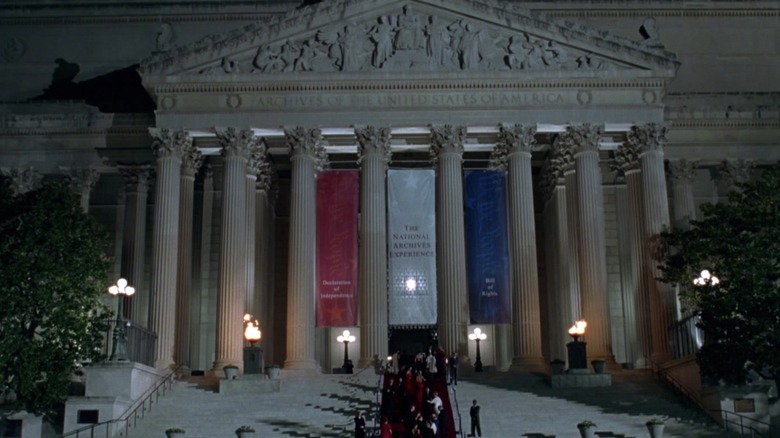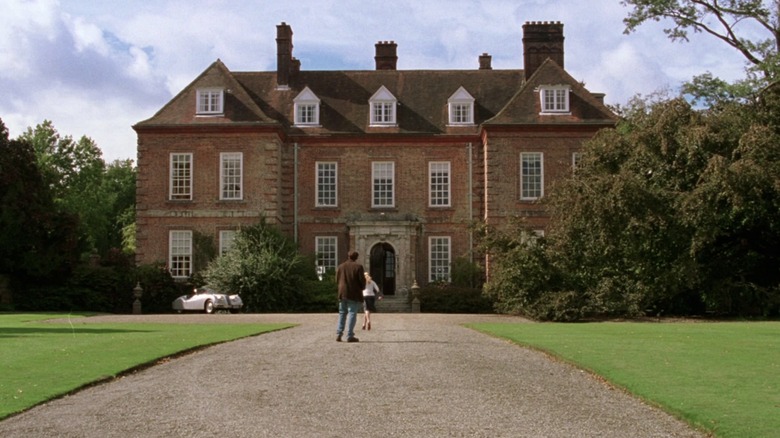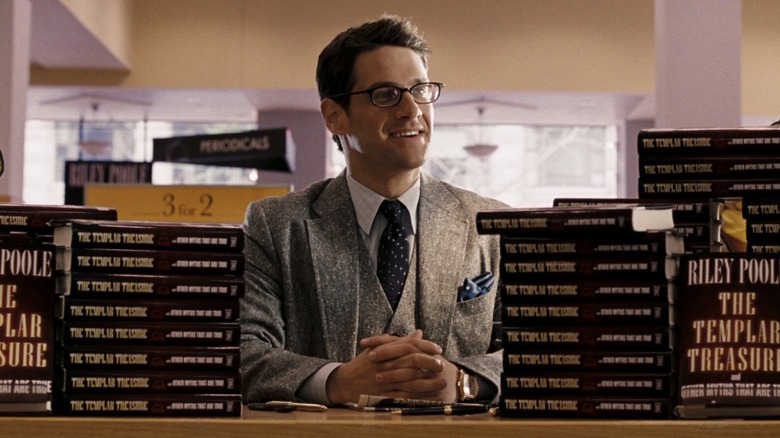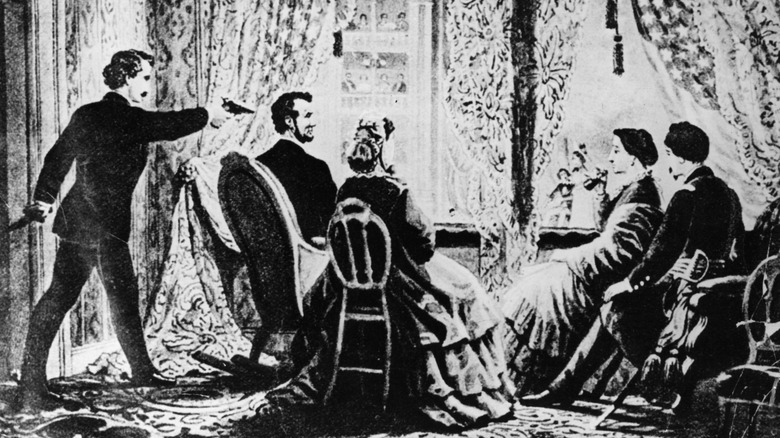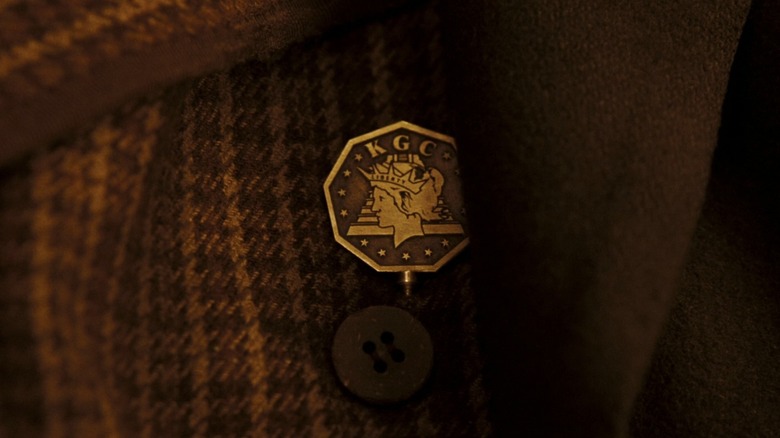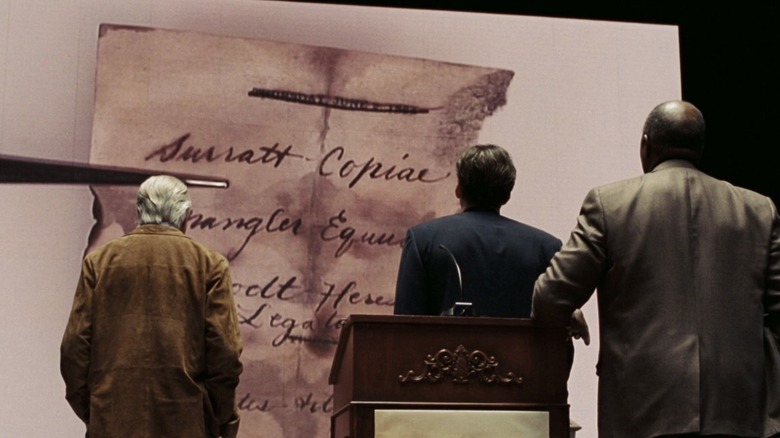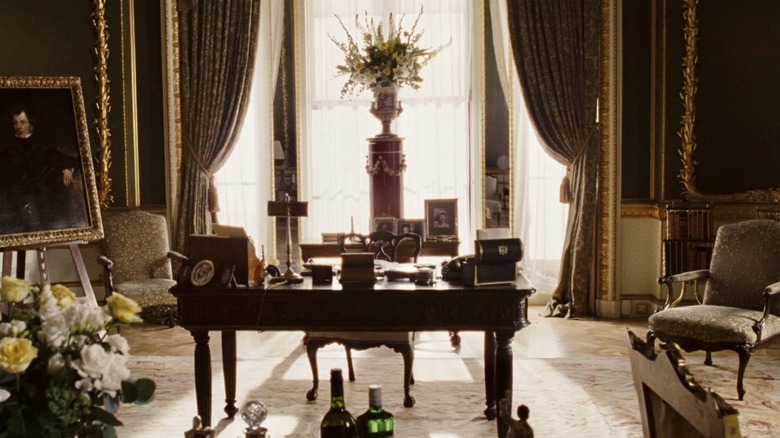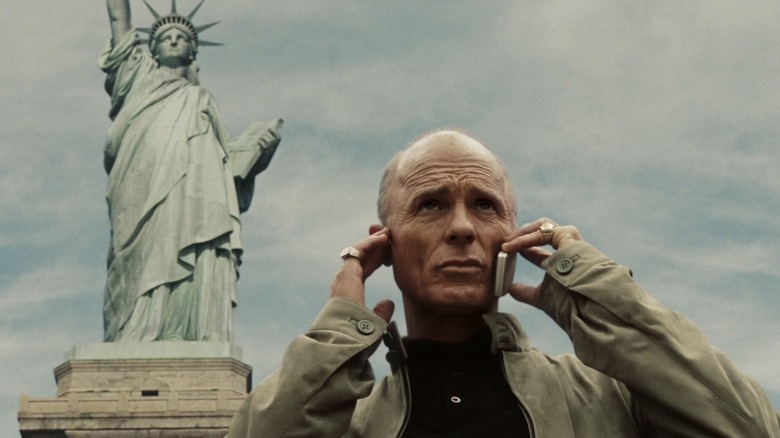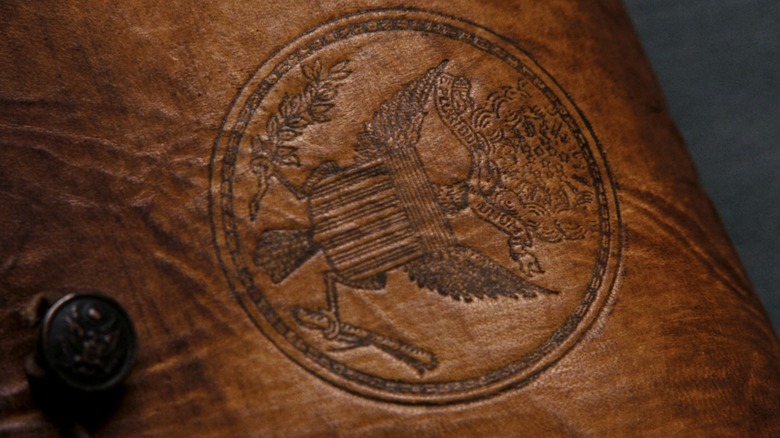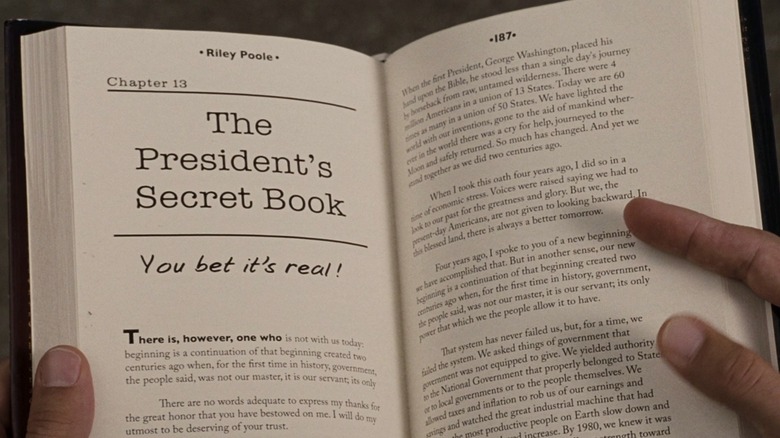Small Details Everyone Missed In The National Treasure Movies
After "National Treasure" hit screens in 2004, annual visits to the National Archives in Washington D.C. shot up by 40%. The film clearly reinvigorated many viewers' interest in U.S. history and treasure hunting. Although there is plenty of true history included in the films, there are also details that are inaccurate or misrepresented, and some that are just pure fiction.
Of course, the alchemy of fact, fiction, and fable is part of the appeal of the "National Treasure" films. If you're an early American history expert like Ben Gates (Nicolas Cage) or Abigail Chase (Diane Kruger), you can probably parse historical fact from historical fiction in "National Treasure: Book of Secrets" and the original film. But the average viewer is probably more like Riley Poole (Justin Bartha), not worrying too much about historical accuracy while watching either of the movies. Here are some small details you may have missed in the "National Treasure" movies and how they play into the greater story.
It's very unlikely Charles Carroll was a Mason
"National Treasure" begins when a young Ben Gates (Hunter Gomez) hears a story about his family's past from his grandfather, John Adams Gates (Christopher Plummer). The legend says that Charles Carroll (Terrence Currier) entrusted their ancestor Thomas Gates (Jason Earles), Carroll's coach driver, with the first clue of how to find the Templar treasure before his death in 1832. This story inspired Ben to dedicate his life to searching for the Templar treasure, which most believed was a myth.
Although Thomas Gates is a fictional character, Charles Gates actually was the last living signer of The Declaration of Independence according to the Declaration Resources Project at Harvard University. However, it's unlikely he was also the last living Mason to know where the mythic treasure was hidden. Unlike some of his contemporaries who also signed The Declaration, Carroll was a devout Roman Catholic – the only one to sign the document. As a devoted Catholic, it's unlikely Carroll was a Mason.
In 1738, the Catholic Church forbade its members from joining Masonic orders under threat of excommunication. This policy remained until 1983, when the church seemed to abandon the overt excommunication language but maintained that Masonic members could not receive Holy Communion, as they were still seen as being "in a state of grave sin," according to the Vatican.
The Masons did not evolve out of the Knights Templar
Ben's grandfather says that the Knights Templar gathered treasure during the crusades and took it upon themselves to protect it. According to him, the Freemasons evolved out of the Knights Templar and moved the treasure from England to America. This idea is foundational to "National Treasure," but the detail about the origins of the Masons is completely false. According to National Geographic, the Masons didn't evolve out of the Knights Templar. When the group was founded, the Knights Templar hadn't existed for hundreds of years.
It isn't surprising that the "National Treasure" franchise would latch onto this popular conspiracy theory given its subject matter. According to History, Pope Clement V joined forces with King Philip IV in 1307 to eradicate the Knights Templar after the group continued gaining power. High-ranking members were arrested, tried for heresy and other crimes, and tortured until they confessed. In 1312, the Catholic church officially dissolved the Templars.
Per the Washington Library at Mount Vernon, the origins of the Freemasons aren't exactly known, but they emerged in the British Isles between 1599 and 1721 when they published their first manifesto, "The Constitutions of the Free-Masons." In 1732, a lodge was founded in Boston — the oldest lodge in the U.S. Many colonial elites joined the Masonic orders, and this fraternal organization helped contribute to the ideals that inspired the American Revolution, making an indelible mark on U.S. history.
Fifty-six men actually signed The Declaration of Independence
Even films about history get some details wrong. According to the Declaration Resources Project, fifty-six men actually signed the Declaration of Independence, not fifty-five, as stated in the riddle Ben and his associates glean from the meerschaum pipe they find aboard the Charlotte.
This clue leads Ben to believe there is an invisible map on the back of the Declaration of Independence. Although the number fifty-five referenced in the riddle is historically incorrect, it isn't entirely just made up. After voting for independence on July 4th, 1776, Thomas McKean traveled to Pennsylvania, where he served as colonel of the Fourth Battalion. He signed the parchment sometime later after January 1777, and possibly not until 1781, according to the Declaration Resources Project. While it's possible that the inscription Ben reads was written sometime in that interim, or that he accounts for McKean in his solving of the riddle, this also may simply be a mistake on the part of the filmmakers.
2004 really was the National Archives' 70th anniversary
In "National Treasure," Ben and Riley use the distraction of the 70th-anniversary gala at the National Archives to steal The Declaration of Independence. Interestingly enough, when the film was released, it really was the National Archives' 70th anniversary, according to the organization. In June of 1934, the Archives became an independent agency under President Franklin D. Roosevelt. In November of 1935, the first staff members moved into the building while it was still under construction.
It wasn't until December of 1952 that the Declaration of Independence, the Constitution of the United States, and the Bill of Rights could be viewed at the National Archives. According to the White House, before the Declaration of Independence became available for viewing in the rotunda at the Archives, it moved around the East Coast and spent time in cities such as Philadelphia, Baltimore, Annapolis, and New York. After moving to Washington D.C. for good, it was stored in various government buildings including the Patent Office, Library of Congress, and Fort Knox during WWII.
Ben bought his estate because it was associated with Charles Carroll
At the end of "National Treasure," before Riley drives away in his red Ferrari, Ben tries telling him why he bought a massive estate with his share of their spoils from the Templar treasure. Ben tells Riley the estate has some connection to Charles Carroll, the historical figure who gave the first clue — "The secret lies with Charlotte" — to Ben's ancestor Thomas Gates, but Riley ignores him.
This definitely feels like a teaser for a sequel, but apparently, it's just another instance of Riley dismissing Ben's prodigious knowledge of early American history. Per E! News, Disney had no plans to make a sequel while in production on "National Treasure." The company only contemplated a follow-up after the first film was commercially successful. As reported by ENews, "Book of Secrets" was greenlit in 2005 and hit screens in 2007, delivering an even bigger haul than the original at the box office.
Riley Poole is the real conspiracy theorist
Although Ben and the entire Gates family have a bad reputation in the historical community (before actually finding the Templar treasure), there are plenty of hints in the first movie that Riley Poole is the real conspiracy theorist in their rag-tag group. We see this hinted at in the first film while the group is descending the precarious spiral staircase into the pit under Trinity Church. Riley makes a sarcastic comment about aliens helping ancient people build the pyramids and the Great Wall of China while they look down into the fragile structure.
Riley's preoccupation with conspiracy theories is front and center in "National Treasure: Book of Secrets." As it turns out, the book he writes is about the Templar treasure and other myths and conspiracy theories that are actually real. Riley's encyclopedic knowledge of conspiracy theories comes in handy when Ben finds the mysterious seal purported to be associated with the fabled President's book, lending the film its name. When he talks about the secrets that could be in the book, it's clear Riley is dying to know the truth about Area 51 and the John F. Kennedy assassination.
Abraham Lincoln and his wife weren't sitting alone
In "National Treasure: Book of Secrets" President Abraham Lincoln and Mary Todd Lincoln are depicted as sitting on a balcony at the Ford theater, by themselves, on the night John Wilkes Booth killed the President. In reality, Lincoln and his wife were actually seated with Major Henry Rathbone and his wife that evening. Per PBS, Rathbone fought with Booth after he shot Lincoln in the head before the assassin jumped to the stage. Other than Lincoln and Mary Todd being depicted as alone, the assassination scene is accurately depicted in the film.
Booth got caught on a flag while jumping from the stage and broke his leg. As depicted in the film, he also yelled the Virginia state motto, "Sic semper tyrannis," and some audience members claimed he also said "the South is avenged" before fleeing to his horse outside. The film doesn't elaborate that the assassination was merely one component of a larger plot to also kill the vice president and the secretary of state, crippling the executive branch of the government. According to PBS, there was an unsuccessful attempt on Secretary Seward that night, but no attempt was made on Vice President Johnson.
Knights of the Golden Circle had disbanded by the end of the Civil War
As depicted in "National Treasure: Book of Secrets," the Knights of the Golden Circle were a militant secret society founded by George Bickley. According to Discovery UK, the KGC planned to expand the Southern States into the Caribbean, Mexico, and Central America, forming a massive pro-slavery empire. Interestingly, according to Discovery UK, some KGC members were also Masons.
"Book of Secrets" tells a story of the KGC searching for the vast treasure of Cibola to resurrect their cause after the confederacy lost the war. However, the group had likely already disbanded by the end of the Civil War. According to Historic Mysteries, the KGC attempted to raise an army to invade Mexico but failed repeatedly to amass the necessary manpower.
When the Southern States left the union, the KGC essentially dissolved, and most members either fought for the Confederacy or acted as spies in the north. While some claim John Wilkes Booth was a member of the KGC, Historic Mysteries argues these claims are baseless. Despite the KGC no longer being active after the war, the group's fervent desire to build an empire and rumored links to buried treasure made them the perfect secret society for "National Treasure: Book of Secrets."
John Surratt escaped and didn't stand trial until 1866
John Wilkes Booth's real-life co-conspirator, John Surratt Jr., is listed at the very top of the burned page from Booth's journal that Mitch Wilkinson (Ed Harris) provides at the beginning of "National Treasure: Book of Secrets." In the film, we're informed that his mother, Mary Surratt, was convicted and hanged after Lincoln's assassination. What the film leaves out is that Mary was the first woman executed by the federal government in the United States. Some historians believe that if John hadn't evaded authorities, he could have saved his mother.
According to History, John Surratt initially escaped capture by going to Canada and then to Europe, where he claimed to be Canadian. Authorities finally arrested him in Egypt, and he stood trial in 1866. Unlike his mother, Surratt had a civilian jury rather than a military tribunal. During his trial, John admitted to conspiring with Booth to kidnap the president but denied ever being part of a plot to kill Lincoln. The jury failed to convict him, and he was set free. Per History, both John and his sister Anna became school teachers. John married and had seven children before his death in 1916.
There are actually three Resolute desks
Like its predecessor, "National Treasure: Book of Secrets" builds on historical facts to create an interesting plot, but it often verges into fiction. After traveling to Paris and finding a riddle inscribed on the torch of Paris' miniature Statue of Liberty, Ben surmises the next clue is contained in a Resolute desk. He explains how two Resolute desks were made from timber salvaged from the British vessel HMS Resolute, which the U.S. recovered and returned to the U.K. He also explains how Queen Victoria gifted one desk to Rutherford B. Hayes, landing it in the Oval Office, while its counterpart resides in Buckingham Palace.
While it is true that desks were made of timber salvaged from the HMS Resolute, there were actually three desks made, and none of them look alike as the film implies when the riddle calls them "twins." According to the New Bedford Whaling Museum, Queen Victoria gifted one desk to the U.S. president in 1880, and as stated in the film, it has been used by every president since, except Presidents Johnson, Nixon, and Ford. As depicted in the film, Queen Victoria kept a Resolute desk of her own in Buckingham Palace, though it has also spent time more recently at the Royal Naval Museum in Portsmouth, England. The third desk is known as the Grinnell Resolute desk and was donated to the New Bedford Whaling Museum in 1983.
Laboulaye was an abolitionist and wouldn't help the Confederacy
Édouard Laboulaye's importance to the plot of "National Treasure: Book of Secrets" can't be understated, but he isn't depicted accurately in the film. According to the National Parks Service, Laboulaye suggested gifting the U.S. the Statue of Liberty to celebrate the Northern victory during the Civil War, and an America dedicated to equality. Laboulaye also recruited artist Frédéric-Auguste Bartholdi to make the statue. Per Britannica, in 1884, the massive sculpture was completed and presented to the American minister to France, before being shipped to America. Unfortunately, Laboulaye didn't survive to see the completed statue, nor was he alive when the smaller version took its place in Paris in 1889. Laboulaye died May 25, 1883.
The riddle that begins Ben's search for Cibola is found on the smaller statue in Paris. Later in the film, Wilkinson reveals a letter that his ancestor, a Confederate general, received from Queen Victoria, saying that Laboulaye left clues to the treasure on the statue before his death. These convoluted riddles are a mainstay of the "National Treasure" franchise, but the riddle is pure fiction. Laboulaye was an abolitionist and an avid supporter of Lincoln and the Union. Because of these ideals, he would never leave hidden messages to aid the Confederacy. Laboulaye believed in democracy, freedom, and equality, and it's highly unlikely he would have helped the KGC find Cibola to fund a new Civil War.
Abigail describes the seal for the Book of Secrets inaccurately
When Ben and Abigail talk their way into visiting the Oval Office during the Easter egg roll at the White House, Ben opens the secret compartment in the president's Resolute desk and finds a stamp. When he shows a picture of the seal to Abigail, Riley, and Patrick (Jon Voight), Abigail describes the seal incorrectly, saying the eagle is holding a scroll instead of olive branches.
It's a small goof, but the eagle is actually holding the scroll instead of the arrows, and the olive branch is still clutched in the eagle's other talon. This symbol, which is similar to the presidential seal, is associated with the fabled president's secret book. When he sees the seal, Riley has a chance to show off his conspiracy theory knowledge, showing everyone the chapter in his book dedicated to the topic.
Although the Book of Secrets was created for the movie, it has maintained an urban legend status. The Library of Congress has even gone so far as to address and deny the book's existence. Per CBS News, President Obama jokingly alluded to the book being real during an interview in 2009.
Page 47 was definitely mentioned to set up a third film
When the President (Bruce Greenwood) asks Ben to check out page 47 of the Book of Secrets, you might think it has something to do with the plot of the movie. But when he follows up with Ben about the mysterious page after the discovery of Cibola, it feels more like the setup for a third film in the franchise.
In the Disney+ series "National Treasure: Edge of History," Justin Bartha reprises his role as Riley Poole, who teases a third film in Episode 4 when he tells Jess (Lisette Olivera) he hasn't retired. Riley says, "Ben and I have been working on this super important thing for the last three, four, 15 years." When the series premiered in 2022, it had been 15 years since "Book of Secrets" hit the screens. Riley then mentions the number 47, calling back to the mysterious page from the president's book. A third film was rumored for years, and Jerry Bruckheimer told E! News in 2022 that it's still in the works, with Nicolas Cage potentially returning to star.
